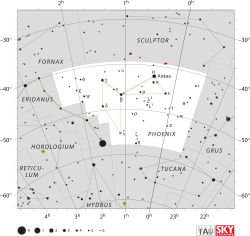Phoenicids
The Phoenicids are a minor meteor shower, first noticed by observers in New Zealand, Australia, the Indian Ocean, and South Africa during an outburst of approximately 100 meteors an hour that occurred during December 1956. Like other meteor showers, the Phoenicids get their name from the location of their radiant, which is in the constellation Phoenix. They are active from 29 November to 9 December, with a peak occurring around 5/6 December each year,[1] and are best seen from the Southern Hemisphere.
| Phoenicids | |
|---|---|
 Celestial map of Phoenix | |
| Discovery date | 1956 |
| Parent body | 289P/Blanpain |
| Radiant | |
| Constellation | Phoenix |
| Right ascension | 1h 12m -0s |
| Declination | −53° 00′ 00″ |
| Properties | |
| Occurs during | November 28 to December 9 |
| Date of peak | December 2 |
| Velocity | 18 km/s |
| Zenithal hourly rate | Variable |
The Phoenicids appear to be associated with a stream of material from the disintegrating comet D/1819 W1 (Blanpain).[2]
A very minor meteor shower with a radiant in Phoenix also occurs in July; this shower is referred to as the July Phoenicids.[3]
References
- "Archived copy". Archived from the original on 18 September 2009. Retrieved 24 November 2009.CS1 maint: archived copy as title (link)
- P. Jenniskens and E. Lyytinen, METEOR SHOWERS FROM THE DEBRIS OF BROKEN COMETS: D/1819 W1 (BLANPAIN), 2003 WY25, AND THE PHOENICIDS.The Astronomical Journal, 130:1286–90, 2005 September
- "Archived copy". Archived from the original on 24 January 2010. Retrieved 24 November 2009.CS1 maint: archived copy as title (link)